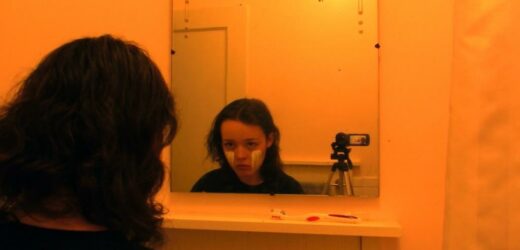In its first scene, “We’re All Going To the World’s Fair” seems to be setting up a standard found footage horror film: a girl named Casey (Anna Cobb) opens her laptop and records a YouTube video announcing she will participate in a strange online trend, “The World’s Fair Challenge,” one that has supposedly has caused other people to experience disturbing changes to their bodies. But when Casey is contacted by a much older man, going by the username JLB (Michael Rogers), the film reveals itself to be something much stranger and far more tender: a coming-of-age story about being lonely and lost, and the vulnerability of sending a piece of yourself into the online void hoping someone will respond.
“We’re All Going To the World’s Fair” is directed by Jane Schoenbrun, a trans and non-binary filmmaker and curator who wrote the film during a dark period in their life, before they began physically transitioning, while they reflecting on their experiences on the internet as a young queer kid in the early 2000s. At the time, Schoenbrun spent most of their online life on horror film forums and writing “Buffy the Vampire Slayer” and “X-Files” fanfiction. After revisiting these memories, Schoenbrun put pen to paper, and tried to capture their own unique, queer understanding of what it means to be online.
“A lot of work that has been made about the internet tends to be very maximalist,” Schoenburn says. “This idea of the internet as this insane space where codes, tabs, algorithms are flying at you at the speed of light. And I was interested in making something about the internet that I knew growing up and that I still know now, which can feel quite lonely, quite boring. A space where you spend all day staring at a box that’s reflecting you back at yourself.”
Since premiering at Sundance last year, “We’re All Going to the World’s Fair” has been a breakout moment for Schoenbrun, a visual artist and curator who currently works for the Brooklyn Academy of Music, where they recently curated the series “Photographing the Ether: The Internet on Film.” The film will be the first in what Schoenbrun is calling their “Screen Trilogy,” which includes a TV project they’re working on and the upcoming film “I Saw the TV Glow,” which will be distributed by A24.
With their movie opening in New York this week, Variety talked to Schoenbrun about making their directorial debut, getting Alex G to write the score and the dysphoric nature of the internet.
Can you talk a bit about your influences that inspired the internet that we see in the film? How’d you try to mimic the language of the internet through filmmaking?
The internet that we see in the film, I always describe as not realistic, but my dream of the internet that I knew. The thing the film is reflecting on most viscerally is an internet I used as a lifeline as a young queer kid, trying to figure themselves out online in 2000, 2001. This was a really different internet that was less dominated by these tech monoliths and these spaces that we’re all engaged in constantly now. It was a place where you could find these strange crevices to hide online. I spent a lot of time in my parents’ basement after everyone else had gone to sleep on various horror movie forums, fan fiction forums. I used to write my own fledgling horror stories at 13 years old. It was all about the safety of anonymity, and the safety of creating a self or experimenting with various versions of self detangled from physical form and from an identity that I couldn’t control. And it was a space of dysphoria as a trans person who didn’t have any kind of language to understand myself in that way at age 13. It was important to me that it feel truthful to not just what’s scary or sad or dark about the internet, but what can be enticing and beautiful about the internet.
That idea of dysphoria is very interesting to me. I feel like its something I can feel subliminally about the film, but it’s hard to articulate why. What is it about the internet that connects it to that concept of dysphoria?
It’s a space where you can exist without a physical form and without a body, so it’s obviously enticing if you’re not in the right body and trying to sort of escape yourself or create a new identity outside of the restrictions of physical form in the real world. This glowing light is very liminal. And that kind of liminality, when life really does feel like a dream, can be quite comforting when you feel like you’re not actually alive or this life that you’re living is somebody else’s, which are very under-discussed, very common traits of dysphoria and repressed transness. And when you make an internet video, there’s some premeditation going on about how you’re presenting yourself in the video. I was interested in the ways all of the characters in the film choose to present themselves, the premeditation of the performance that they’re doing. When you talk about dysphoria and transition, one of the core things you’re talking about is how you’re seen and how you want to be seen. And the horror of perception is something that trans people understand uniquely.
Where did you come up with the name, “The World’s Fair Challenge?” Was there something about the real life World’s Fair that inspired you?
I was really trying, in creating this film, to listen to my subconscious. The association on YouTube autoplay from one video to the next maybe isn’t a conscious association, but is closer to the way that spaces will connect in dreams. I was really trying to get myself into a mindset where I could authentically mimic that in my creative process. I had read a book called “Imaginary Futures,” which was a book of theory that used the World’s Fair as its jumping off point to talk about this idea of the futures that we imagined for ourselves versus the realities that eventually exist. I read that book, and then months later on a long walk, the name “We’re All Going to the World’s Fair,” came to me in my brain.

The film features a ton of real-life internet creators, who star in the videos the audience sees of the “World’s Fair Challenge.” How did you reach out to those people and shoot those fake videos to develop the internet world this film takes place in?
It was really important to me that the the videos we saw in the film felt like real videos that actually existed, which are made with a lot of love, and they didn’t feel like pastiche or parody. Because then the film is speaking down to the world that it’s trying to represent. It felt really important for me to open the film up to this crowdsourced process through which these kinds of myths actually get built. A lot of credit goes to Abbey Harri, my casting director, who did tons of research into these communities and found people like Evan Santiago, who makes amazing no-budget horror work on the internet, and essentially did that for a scene in my movie. I went to Dallas, Fort Worth to film a 12-second scene with a YouTuber who I really like named Nyx Fears, who makes amazing horror criticism on YouTube. It was important to film that scene with her in the house where she lives, on the camera that she uses to make her videos and to basically create a self-portrait of her that could live in film. Every one of those videos was dictated by who the collaborator was going to be and what felt like the most authentic collaboration.
How did Alex G come on to write the score for the film? There’s synergy in his involvement: this is a film about being young on the internet, and he’s a musician who got his start as a teenager, self-releasing his music on Bandcamp.
I was a fan of Alex’s for many years and wrote the film listening to his music. Especially his home recordings from that Bandcamp era, they feel really homemade. The term for his music that people use sometimes is “bedroom music,” and I would talk about wanting to make a “bedroom film,” a film that didn’t feel cheap, but homemade and had an intimacy and a mystery to it. When we wrapped, I wrote him a fan letter about all of that and why I felt there was this connection between what I was trying to do and what he had done in his music so vividly. It was like a dream come true — you get an immediate response from one of your rockstar heroes and he wants to collaborate because he likes the film and then pretty soon you’re on the phone with him and you’re getting sent little voice memos of demos. It was like the final spice that needed to be added to the dish that I was trying to cook. The film is obviously genre influenced and has this darkness and plays with a lot of genre conventions, but it’s also something that’s trying to be unusually tender and genuine and emotive for the genre. It’s as interested in making you cry as it is scaring you. And Alex’s music adds such a rich layer of emotion and vulnerability that really brought that side of it to life.
Since so much of this movie was inspired by your personal experiences with the internet, how did you cast for Casey? I loved Anna Cobb in the role, were you looking for someone that reminded you of who you were as a teen at all?
We needed a magnetic performer, someone that was fascinating to us and somebody who you could build a movie around not much more than their nonverbal stare. We did a massive search. We looked at all genders for the role. I personally spent two or three months just sifting through every crevice of the world where I could find a potential star for the movie. And generally speaking, teen actors are sort of trained to present as heightened in some way rather than somebody who feels like you could have just come across their videos at 2 a.m. with 14 views online. I spent a very dark two days reading through every single entry on the YouTube Wiki of every significant YouTuber wondering if there was somebody on there magnetic enough to play Casey. And then I saw Anna’s headshot. She reminded me a little bit of Billie Eilish, and I was like, “Oh, that’s an interesting look.” It was also an incredibly different headshot, it was taken in a bathroom mirror, not professionally. It felt like something Casey would have uploaded in the film. Then we saw Anna’s tape. We had people tape, documentary style, answering some questions and talking about themselves and then do a scene. And Anna had this unique ability of being so incredibly natural and herself. She’s such a strong personality and the role really did fuse with the person in really organic ways. But she also had phenomenal chops. She could carry a scene in a way that left us all in awe. It’s a very rare thing to find somebody who can be so themselves but also take their craft so seriously.

Like you were saying, a lot of this film is one of the two main characters alone on their computer. We don’t see them interacting with anyone offline. How do you direct your actors to give natural performances without a scene partner to really play off of?
Especially with Anna, there was a lot of choreography before we made the movie. We worked together for about five or six months, doing a number of non-traditional exercises. I had her study the creepypasta community. One thing about Anna is that she doesn’t really use the internet. She doesn’t like horror movies. So, there was a little bit of a learning curve getting her in the headspace of the character. She would make these YouTubes in character where she would be improvising. We would watch them together and talk about what moments felt really lived in. From there it was a process of just merging who this person was and making it personal for her, but also continuing to develop and understand the character in a really deep way. By the time we got to set, she understood it like the back of her hand. And that really enabled a lot of the most special moments. It’s a very structured film, but there is a lot of improv. And we only were able to do that because of how deeply we prepped and how deeply Anna understood this character by the time we started filming.
The relationship between Casey and JLB surprised me. Almost any viewer’s first assumption is that their relationship will turn predatory, and the film certainly acknowledges that possibility, but it doesn’t quite go there. Were you intentionally trying to subvert expectations with that?
One of the core ideas is the ambivalence of online relationships. It can be really hard to know what people want from you at any given moment. The film is loosely inspired by an actual relationship that I had with a much older person online that felt similarly ambivalent. It was weird enough that it had to have felt wrong for this 35-year-old man to be talking to a 13-year-old kid online, but it never went to any place that was explicitly physically predatory. So I’m left with lots of questions about what that person was looking for. And I think that this says something about the internet, the way that, like in real life, but in perhaps a heightened way, you don’t get easy answers about what people are looking for from you.
What about the ending, and how it ends up leaving Casey’s perspective and entering JLB’s — what inspired that? Why did you want that transition in terms of perspective?
Transition is a funny word there.
Oh, yeah. That was not intentional.
No, but there is something happening there in terms of what the film is talking about. In a certain way I’m reflecting on the distance I felt from that young person that I once was. Also, the film is filled with unreliable narrators. Everyone is an unreliable narrator because they’re performing and that’s what we do on the internet, and honestly, that’s what we do in our lives. Another core idea of the internet is that it doesn’t work like a movie. There’s no narrative catharsis. There’s no three act structure. Sometimes people disappear, and you never know if they’re still alive, if they just deleted their account, they got bored, where they are in life. This person that I had this strange, potentially toxic relationship with online when I was a young person, I wouldn’t know where to find him if I wanted to. Which I don’t.
The conversation has been edited for clarity.
Source: Read Full Article


